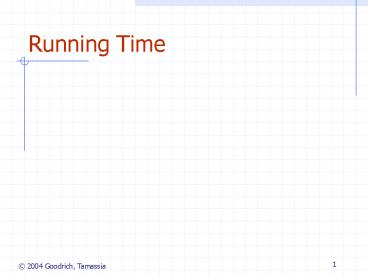Running Time - PowerPoint PPT Presentation
1 / 15
Title:
Running Time
Description:
Run the program with inputs of varying size and composition ... 2004 Goodrich, Tamassia 2004 Goodrich, Tamassia. 7. The Random Access Machine (RAM) Model ... – PowerPoint PPT presentation
Number of Views:15
Avg rating:3.0/5.0
Title: Running Time
1
Running Time
2
Experimental Studies
- Write a program implementing the algorithm
- Run the program with inputs of varying size and
composition - Use a method like System.currentTimeMillis() to
get an accurate measure of the actual running
time - Plot the results
3
Limitations of Experiments
- It is necessary to implement the algorithm, which
may be difficult - Results may not be indicative of the running time
on other inputs not included in the experiment. - In order to compare two algorithms, the same
hardware and software environments must be used
4
Theoretical Analysis
- Uses a high-level description of the algorithm
instead of an implementation - Characterizes running time as a function of the
input size, n. - Takes into account all possible inputs
- Allows us to evaluate the speed of an algorithm
independent of the hardware/software environment
5
Pseudocode
- High-level description of an algorithm
- More structured than English prose
- Less detailed than a program
- Preferred notation for describing algorithms
- Hides program design issues
6
Pseudocode Details
- Control flow
- if then else
- while do
- repeat until
- for do
- Indentation replaces braces
- Method declaration
- Algorithm method (arg , arg)
- Input
- Output
- Method call
- var.method (arg , arg)
- Return value
- return expression
- Expressions
- Assignment(like ? in Java)
- Equality testing(like ?? in Java)
- n2 Superscripts and other mathematical formatting
allowed
7
The Random Access Machine (RAM) Model
- A CPU
- A potentially unbounded bank of memory cells,
each of which can hold an arbitrary number or
character
- Memory cells are numbered and accessing any cell
in memory takes unit time.
8
Primitive Operations
- Basic computations performed by an algorithm
- Identifiable in pseudocode
- Largely independent from the programming language
- Exact definition not important (we will see why
later) - Assumed to take a constant amount of time in the
RAM model
- Examples
- Evaluating an expression
- Assigning a value to a variable
- Indexing into an array
- Calling a method
- Returning from a method
9
Seven Important Functions
- Seven functions that often appear in algorithm
analysis - Constant ? 1
- Logarithmic ? log n
- Linear ? n
- N-Log-N ? n log n
- Quadratic ? n2
- Cubic ? n3
- Exponential ? 2n
- In a log-log chart, the slope of the line
corresponds to the growth rate of the function
10
Big-Oh Notation
- Given functions f(n) and g(n), we say that f(n)
is O(g(n)) if there are positive constantsc and
n0 such that - f(n) ? cg(n) for n ? n0
- Example 2n 10 is O(n)
- 2n 10 ? cn
- (c ? 2) n ? 10
- n ? 10/(c ? 2)
- Pick c 3 and n0 10
11
Big-Oh Example
- Example the function n2 is not O(n)
- n2 ? cn
- n ? c
- The above inequality cannot be satisfied since c
must be a constant
12
More Big-Oh Examples
- 7n-2
- 7n-2 is O(n)
- need c gt 0 and n0 ? 1 such that 7n-2 ? cn for n
? n0 - this is true for c 7 and n0 1
- 3n3 20n2 5
3n3 20n2 5 is O(n3) need c gt 0 and n0 ? 1
such that 3n3 20n2 5 ? cn3 for n ? n0 this
is true for c 4 and n0 21
- 3 log n 5
3 log n 5 is O(log n) need c gt 0 and n0 ? 1
such that 3 log n 5 ? clog n for n ? n0 this
is true for c 8 and n0 2
13
Relatives of Big-Oh
- big-Omega
- f(n) is ?(g(n)) if there is a constant c gt 0
- and an integer constant n0 ? 1 such that
- f(n) ? cg(n) for n ? n0
- big-Theta
- f(n) is ?(g(n)) if there are constants c gt 0 and
c gt 0 and an integer constant n0 ? 1 such that
cg(n) ? f(n) ? cg(n) for n ? n0
14
Intuition for Asymptotic Notation
- Big-Oh
- f(n) is O(g(n)) if f(n) is asymptotically less
than or equal to g(n) - big-Omega
- f(n) is ?(g(n)) if f(n) is asymptotically greater
than or equal to g(n) - big-Theta
- f(n) is ?(g(n)) if f(n) is asymptotically equal
to g(n)
15
Example Uses of the Relatives of Big-Oh
- 5n2 is ?(n2)
f(n) is ?(g(n)) if there is a constant c gt 0 and
an integer constant n0 ? 1 such that f(n) ?
cg(n) for n ? n0 let c 5 and n0 1
- 5n2 is ?(n)
f(n) is ?(g(n)) if there is a constant c gt 0 and
an integer constant n0 ? 1 such that f(n) ?
cg(n) for n ? n0 let c 1 and n0 1
- 5n2 is ?(n2)
f(n) is ?(g(n)) if it is ?(n2) and O(n2). We have
already seen the former, for the latter recall
that f(n) is O(g(n)) if there is a constant c gt 0
and an integer constant n0 ? 1 such that f(n) lt
cg(n) for n ? n0 Let c 5 and n0 1































